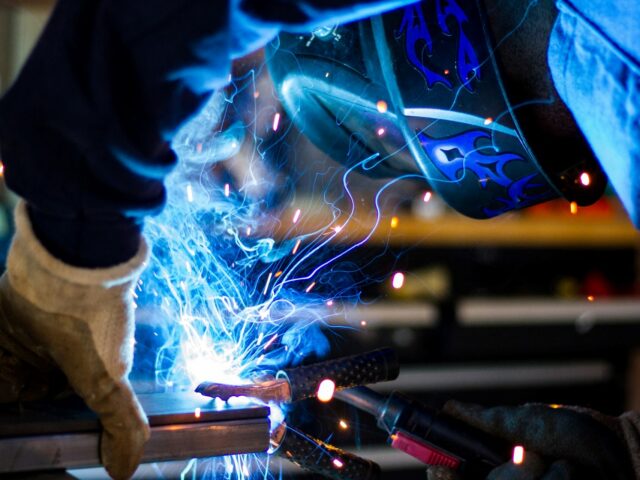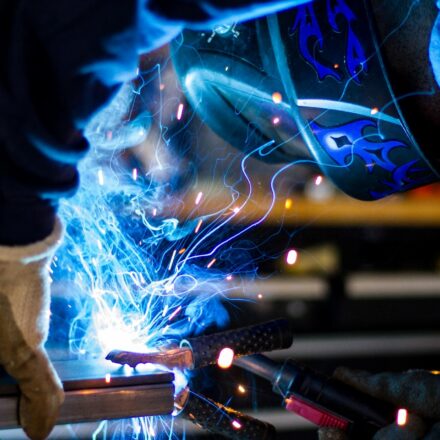By Debra Slapak, Edge Innovation and Thought Leadership Marketing Lead at Dell Technologies
Between the 1960s and 1980s, Opal worked as an inspector in a single-engine aircraft factory. On her first day, she was issued a set of welding gauges and a small paper handbook. After a few hours of training, she was on her own. For 18 years, she carpooled 30 miles each way, five days a week, to inspect the gaps between welded panels at her workbench and inside the narrow confines of fuselages. She rejected those that did not conform.
She stood for eight hours during the day; the physical stress was relieved only by a few short breaks. Anti-fatigue mats and high-tech “standing” shoes were not yet invented, and adequately heating and cooling the vast, hangar-like building was not in the razor-slim budget. In the early winter mornings, her breath lingered about her face, cloudy in the frigid air.
By high noon during the peak of summer, the temperatures could approach a dizzying 115⁰F. Dehydration, migraines and repetitive stress injuries were her frequent companions. But Opal couldn’t let her concentration lapse. Her judgments had life and death consequences.
Sometimes welders took her exacting standards and quality rejections personally. A few questioned her decisions. She remained steadfast because she thought that one day her children might go up in one of her planes. To show that she believed in her work, she flew with one of the test pilots just once, on her first-ever airplane ride.
That was two generations ago. Since then, improved working conditions and access to modern manufacturing equipment have become standard in many contemporary factories. Now, machine intelligence can inspect output and confirm conformance at speed without repetitive injury or losing concentration.
Revisiting the trying conditions on the factory floor all those years ago with the hero of my personal story–my factory worker mom–has made me treasure her even more. That job, her sacrifice, sent me to college–a rare thing among my cohort at the time. While I was there, a friend offered me a ride in a single-engine plane made at my mom’s factory during her employment. I took it.
Today, Mom is fascinated to hear about how modern factories rely on data and automation to do many of the hard physical and monotonous tasks like those she did long ago. But she worries whether this means people won’t have jobs. I explain to her that if she were working today, technology would give her access to a better job. She might be learning how to build parts from 3D printers, maintaining or helping deploy and train co-bots, or developing artificial reality or virtual reality courses to teach others how to do new tasks.
Addressing labor challenges with 5G and edge
Even as technology plays an important and increasing role in improving working conditions and quality in many factories, manufacturers continue to face staffing challenges, and many vacancies are going unfilled. In November 2020, the U.S. Census Bureau reported that one-fourth of the manufacturing workforce in the U.S. is currently over age 55. As these factory workers “age out” of the economy, others are leaving manufacturing for jobs in areas such as professional services and administrative and support services.
Manufacturers are increasingly turning to data and automation to stay competitive and help retain skilled workers through better working conditions and the potential to grow professionally. Two key technologies in the enterprise toolkit making these outcomes possible are edge computing and 5G. These enable manufacturers to gather, analyze and instantly act on information flowing in from devices, sensors, assembly lines and other data sources in their factories and their supply chains. With these technologies, enterprises can shift many traditional jobs that are repetitive, dull and dangerous to machines, while factory workers can be trained for higher-level roles requiring greater human judgment and creativity.
In recent Dell Technologies sponsored research with 350 manufacturing leaders, a vast majority of respondents agree that edge computing and 5G connectivity are essential to manufacturing transformation.

Early wins
Already, machine vision solutions that capture and analyze real-time data–with the help of 5G connectivity and AI–recognize defects at more efficient rates than humans can.
Welding and welding quality checks are being improved with self-adjusting high-precision robot arms that learn from feedback based on quality data fed into artificial intelligence/machine learning applications.
“Co-bots,” such as autonomous mobile robots, carry parts and assemblies to where they are needed, saving workers time, improving process flows, and reducing physical labor and the risk of injury.
Modern companies are deploying extended reality technologies to immerse workers in virtual spaces where they can observe and practice new tasks in a safe environment, without impacting production operations.
These examples only touch on the potential that edge computing and 5G have, to make manufacturing infinitely safer, more economical and productive. In a July 2020 Dell Technologies study with 800 IT decision-makers (ITDMs), almost three-quarters (73%) of those surveyed estimated that with edge technology, product recalls will become a thing of the past by identifying production line errors immediately.
Don’t forget the workplace redesign
I’m not suggesting that technology alone is a panacea. As manufacturers adopt new technologies, they must continuously reimagine their business models. Professor Erik Brynjolfsson, Director of Stanford University’s Digital Economy Lab recently sat down with Bit Rambusch, VP of Enterprise Services at Dell Technologies. During their conversation, Brynjolfsson delved into history to underline the importance of marrying technology with workplace redesign.
As some manufacturers in pockets of the world have shifted their model toward intelligent automation and upskilled workers to support this new model, Brynjolfsson cautions developing nations that have built industries on cheap labor to also compete on higher skills, not just on low-wage manufacturing. He posits that the process might be challenging at first, but the result will be more productive and equitable.
We all know that technology alone is not a magic pill. But when you introduce disruptive technologies into a culture of people-first reinvention, you can change the world.
Learn more about what manufacturing leaders think about the challenges, impact and adoption of edge computing and 5G in this video, infographic and ebook.
Lead photo by Rob Lambert on Unsplash

